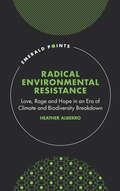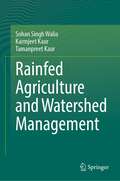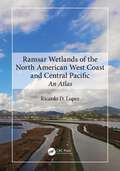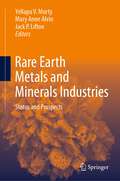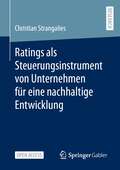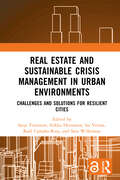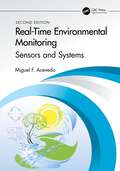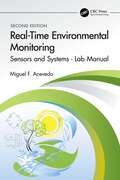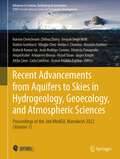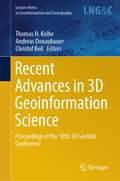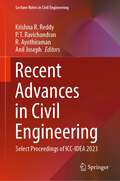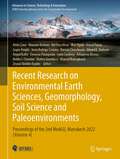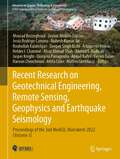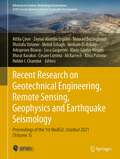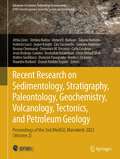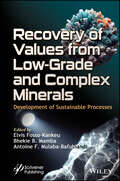- Table View
- List View
Radical Environmental Resistance: Love, Rage and Hope in an Era of Climate and Biodiversity Breakdown (Emerald Points)
by Heather AlberroAcknowledging mounting socioeconomic inequality, a climate system in disarray, and a collapse of biodiversity that now threatens the very viability of life on earth for both present and future generations, Radical Environmental Resistance demystifies activists’ ecological worldviews, their tactical motivations, and their diagnostic and prognostic framings. Providing a succinct overview of key aspects of contemporary radical environmental movements, Heather Alberro offers a brief yet in-depth look into the poorly understood aims and motivations of radical environmental activists as increasingly salient actors within global environmental politics. Drawing on semi-structured interviews with activists from a range of environmental groups as well as analysis of activist websites and print materials, chapters feature a critical discussion of the ethics and salience of radical tactics and of attempts by state, media and corporate actors to criminalize and delegitimize environmental activism. Will mainstream policy and government approaches to addressing climate and biodiversity crises amount to too little, too late? At what point, if ever, do desperate times legitimize desperate actions? Exploring the role of direct action within times of severe social and ecological upheaval, Radical Environmental Resistance evokes the rich, diverse world that radical environmental activists and indigenous environmental protectors are fighting for.
Radical Environmental Resistance: Love, Rage and Hope in an Era of Climate and Biodiversity Breakdown (Emerald Points)
by Heather AlberroAcknowledging mounting socioeconomic inequality, a climate system in disarray, and a collapse of biodiversity that now threatens the very viability of life on earth for both present and future generations, Radical Environmental Resistance demystifies activists’ ecological worldviews, their tactical motivations, and their diagnostic and prognostic framings. Providing a succinct overview of key aspects of contemporary radical environmental movements, Heather Alberro offers a brief yet in-depth look into the poorly understood aims and motivations of radical environmental activists as increasingly salient actors within global environmental politics. Drawing on semi-structured interviews with activists from a range of environmental groups as well as analysis of activist websites and print materials, chapters feature a critical discussion of the ethics and salience of radical tactics and of attempts by state, media and corporate actors to criminalize and delegitimize environmental activism. Will mainstream policy and government approaches to addressing climate and biodiversity crises amount to too little, too late? At what point, if ever, do desperate times legitimize desperate actions? Exploring the role of direct action within times of severe social and ecological upheaval, Radical Environmental Resistance evokes the rich, diverse world that radical environmental activists and indigenous environmental protectors are fighting for.
Rainfed Agriculture and Watershed Management
by Sohan Singh Walia Karmjeet Kaur Tamanpreet KaurThis book provides a comprehensive explanation of rainfed farming, dryland agriculture, and watershed management concepts. Despite utilizing all available water resources for irrigation, approximately half of the cultivated land will still rely on rainfall. With limited scope for expanding cultivated areas, meeting future food demands becomes an immense challenge. It is within this context that the significance of dryland agriculture emerges.Indian agriculture relies heavily on the monsoon, making water crucial for sustainable development. Unequal distribution of the global average rainfall (about 1000 mm) contributes to disparities in agriculture and socio-economic conditions. Around 70% of India's agriculture depends on rainfall, producing nearly 44% of the food and supporting 40% of the human and 60% of the livestock population. Even with full irrigation potential, half of cultivated land still relies on rain. Approximately 30% of the country is prone to drought and water scarcity, posing challenges for rainfed agriculture. Inefficient water use affects other inputs, emphasizing the need for resource management and indigenous systems.This book serves as a valuable resource for farmers, students, and scholars by providing guidance on various aspects of rainfed agriculture, dryland farming, and watershed resource management techniques. It aims to optimize the use of irrigation water and foster sustainable agricultural development. Additionally, it caters to the needs of graduate and postgraduate students studying agriculture, offering specific insights relevant to their designated course on rainfed agriculture and watershed management.
Ramsar Wetlands of the North American West Coast and Central Pacific: An Atlas
by Ricardo D. LopezThis is the first comprehensive international atlas featuring all ecological services provided by Ramsar wetlands, with complete views of all Ramsar sites, through remote sensing and mapping. Written by an international expert on wetlands and remote sensing, this atlas is for a broad audience and compiles much-needed information on how the Ramsar wetlands are of significant value to the planet and society and can and should be managed in such a way that supports planetary sustainability. Focused on the 72 designated Ramsar sites along the western coasts of Alaska, Canada, California, Mexico, and the Central Pacific islands, each wetland is articulately documented with respect to its specific ecological functions and services.FEATURES Provides a comprehensive assessment of the key biophysical and societal elements of each Ramsar-designated wetland along the North American West Coast and Central Pacific Brings all designated Ramsar wetlands to the reader in one visually appealing compendium using geospatial technology Aids in highlighting the importance of and options for wetland conservation and restoration worldwide Explains the important role that wetlands play in environmental sustainability, directly supporting the global sustainable development goals of the United Nations Introduces the contributions of the Ramsar Convention on Wetlands to global conservation and restoration This atlas is intended for wetland managers and policymakers involved in the Ramsar Convention activities and for wetland ecologists and other allied environmental scientists and practitioners, such as hydrologists, microbiologists, and botanists. It is also a valuable resource for researchers, faculty, and graduate students affiliated with programs such as wetland ecology, wetland management, environmental studies, environmental management, and survey of wetlands.
Ramsar Wetlands of the North American West Coast and Central Pacific: An Atlas
by Ricardo D. LopezThis is the first comprehensive international atlas featuring all ecological services provided by Ramsar wetlands, with complete views of all Ramsar sites, through remote sensing and mapping. Written by an international expert on wetlands and remote sensing, this atlas is for a broad audience and compiles much-needed information on how the Ramsar wetlands are of significant value to the planet and society and can and should be managed in such a way that supports planetary sustainability. Focused on the 72 designated Ramsar sites along the western coasts of Alaska, Canada, California, Mexico, and the Central Pacific islands, each wetland is articulately documented with respect to its specific ecological functions and services.FEATURES Provides a comprehensive assessment of the key biophysical and societal elements of each Ramsar-designated wetland along the North American West Coast and Central Pacific Brings all designated Ramsar wetlands to the reader in one visually appealing compendium using geospatial technology Aids in highlighting the importance of and options for wetland conservation and restoration worldwide Explains the important role that wetlands play in environmental sustainability, directly supporting the global sustainable development goals of the United Nations Introduces the contributions of the Ramsar Convention on Wetlands to global conservation and restoration This atlas is intended for wetland managers and policymakers involved in the Ramsar Convention activities and for wetland ecologists and other allied environmental scientists and practitioners, such as hydrologists, microbiologists, and botanists. It is also a valuable resource for researchers, faculty, and graduate students affiliated with programs such as wetland ecology, wetland management, environmental studies, environmental management, and survey of wetlands.
Rare Earth Metals and Minerals Industries: Status and Prospects
by Yellapu V. Murty Mary Anne Alvin Jack P. LiftonThis book presents the current status and future prospects of rare earth elements with respect to a multitude of factors, including resource availability, production, and applications. Among the topics covered are the extraction of raw materials, alloying and compound production, applications, resource conservation through recycling, regulatory issues, and potential new resource streams. The chapters are authored by well-known technical experts in their fields, with decades of research, industrial, and governmental policy experience. The book is expected to serve as the first single source reference on rare earth minerals and metals aimed at students, scientists, technologists, government legislators, regulatory agencies, investors, and business leaders. It provides in-depth examination of the importance of rare earth elements to the global economy and their use in technological innovation, including energy, power, transportation, medicine, electronics, and chemical/petroleum industries.
Ratings als Steuerungsinstrument von Unternehmen für eine nachhaltige Entwicklung
by Christian StrangaliesIn diesem Open-Access-Buch wird mit Hilfe einer systemtheoretischen Perspektive untersucht, wie Nachhaltigkeitsratings zu einer sinnvollen Gesellschaft beitragen. In einer grundlegenden Einführung in die Systemtheorie wird erklärt, wie die Selbsterhaltung von sozialen Systemen durch neuen Sinn ermöglicht wird, der auf weiteren Sinn verweist. Daraufhin wird die Notwendigkeit einer nachhaltigen Entwicklung der Gesellschaft systemtheoretisch dargestellt, indem ein pathologisches Wirtschaftssystem beschrieben wird, das die eigene Umwelt zerstört und dadurch immer weniger sinnvolle Anschlussoperationen findet, die weiteren Sinn ermöglichen. Zudem wird erläutert, wie aus systemtheoretischer Sicht ein nachhaltiges Wirtschaftssystem operiert. Es wird ausgeführt, wie durch eine begrenzte Reflexion neuer Sinn für das Wirtschaftssystem erzeugt wird, der im Einklang steht mit den gesellschaftlichen Entwicklungsmöglichkeiten und somit die wirtschaftliche und gesellschaftliche Selbsterhaltung langfristig sicherstellt. Anhand von Nachhaltigkeitsratings wird dann ein konkretes Beispiel angeführt, wie Entscheidungen mit einer begrenzten Reflexion in Unternehmen zu einer solchen sinnvollen Ökonomie beitragen.
Real Estate and Sustainable Crisis Management in Urban Environments: Challenges and solutions for resilient cities
by Sara Wilkinson Saija Toivonen Sirkka Heinonen Ira Verma Raúl Castaño-RosaThe aim of this book is to promote the dynamic resilience of societies by identifying, analysing, and exemplifying the role of space and land use in both anticipated and unanticipated primary and secondary crisis situations. The book brings together the expertise of a unique team of researchers and methods from fields of futures studies, land use planning, social sustainability and wellbeing, architecture, spatial planning, design and real estate economics, and presents a novel understanding of the direct and indirect impacts of possible crises in the space and land use context. It goes on to discuss the concept of resilience and exemplifies potential solutions and offers a holistic and forward-looking approach for crisis management through a lens of social sustainability and wellbeing, making an important contribution to the promotion of wellbeing in the built environment, especially in terms of land and residential space and building use. This book does not only identify barriers and successful incentives in resilient crisis management but also discusses the role of different stakeholders (e.g., households, office workers, real estate owners, space occupants, firms, the public sector, etc.) in crisis management. Finally, international case studies aiming to tackle the challenging landscape of future threats are presented, along with novel tools to support the development of future policies, regulations, and management practices in the built environment, which can increase the dynamic resilience of societies. Overall, this book is essential reading for decision-makers in the public and private sectors, urban developers, space and spatial designers, architects, planners, community stakeholders, real estate investors, facility managers and crisis and corporate responsibility managers.
Real Estate and Sustainable Crisis Management in Urban Environments: Challenges and solutions for resilient cities
by Sara Wilkinson Saija Toivonen Sirkka Heinonen Ira Verma Raúl Castaño-RosaThe aim of this book is to promote the dynamic resilience of societies by identifying, analysing, and exemplifying the role of space and land use in both anticipated and unanticipated primary and secondary crisis situations. The book brings together the expertise of a unique team of researchers and methods from fields of futures studies, land use planning, social sustainability and wellbeing, architecture, spatial planning, design and real estate economics, and presents a novel understanding of the direct and indirect impacts of possible crises in the space and land use context. It goes on to discuss the concept of resilience and exemplifies potential solutions and offers a holistic and forward-looking approach for crisis management through a lens of social sustainability and wellbeing, making an important contribution to the promotion of wellbeing in the built environment, especially in terms of land and residential space and building use. This book does not only identify barriers and successful incentives in resilient crisis management but also discusses the role of different stakeholders (e.g., households, office workers, real estate owners, space occupants, firms, the public sector, etc.) in crisis management. Finally, international case studies aiming to tackle the challenging landscape of future threats are presented, along with novel tools to support the development of future policies, regulations, and management practices in the built environment, which can increase the dynamic resilience of societies. Overall, this book is essential reading for decision-makers in the public and private sectors, urban developers, space and spatial designers, architects, planners, community stakeholders, real estate investors, facility managers and crisis and corporate responsibility managers.
Real-Time Environmental Monitoring: Sensors and Systems - Textbook
by Miguel F. AcevedoWritten 10 years after the publication of the first edition, this updated edition of Real-Time Environmental Monitoring: Sensors and Systems introduces the fundamentals of environmental monitoring based on electronic sensors, instruments, systems, and software that allow continuous and long-term ecological and environmental data collection. It accomplishes two objectives: explains how to use sensors for building more complex instruments, systems, and databases, and introduces a variety of sensors and systems employed to measure environmental variables in air, water, soils, vegetation canopies, and wildlife observation and tracking. This second edition is thoroughly updated in every aspect of technology and data, and each theoretical chapter is taught parallel with a hands-on application lab manual. Emphasizes real-time monitoring as an emerging area for environmental assessment and compliance and covers the fundamentals on how to develop sensors and systems Presents several entirely new topics not featured in the first edition, including remote sensing and GIS, machine learning, weather radar and satellites, groundwater monitoring, spatial analysis, and habitat monitoring Includes applications to many environmental and ecological systems Uses a practical, hands-on approach with the addition of an accompanying lab manual, which students can use to deepen their understanding, based on the author’s 40 years of academic experience Intended for upper-level undergraduate and graduate students, taking courses in civil and environmental engineering, electrical engineering, mechanical engineering, geosciences, and environmental sciences, as well as professionals working in environmental services, and researchers and academics in engineering.
Real-Time Environmental Monitoring: Sensors and Systems - Textbook
by Miguel F. AcevedoWritten 10 years after the publication of the first edition, this updated edition of Real-Time Environmental Monitoring: Sensors and Systems introduces the fundamentals of environmental monitoring based on electronic sensors, instruments, systems, and software that allow continuous and long-term ecological and environmental data collection. It accomplishes two objectives: explains how to use sensors for building more complex instruments, systems, and databases, and introduces a variety of sensors and systems employed to measure environmental variables in air, water, soils, vegetation canopies, and wildlife observation and tracking. This second edition is thoroughly updated in every aspect of technology and data, and each theoretical chapter is taught parallel with a hands-on application lab manual. Emphasizes real-time monitoring as an emerging area for environmental assessment and compliance and covers the fundamentals on how to develop sensors and systems Presents several entirely new topics not featured in the first edition, including remote sensing and GIS, machine learning, weather radar and satellites, groundwater monitoring, spatial analysis, and habitat monitoring Includes applications to many environmental and ecological systems Uses a practical, hands-on approach with the addition of an accompanying lab manual, which students can use to deepen their understanding, based on the author’s 40 years of academic experience Intended for upper-level undergraduate and graduate students, taking courses in civil and environmental engineering, electrical engineering, mechanical engineering, geosciences, and environmental sciences, as well as professionals working in environmental services, and researchers and academics in engineering.
Real-Time Environmental Monitoring: Sensors and Systems - Lab Manual
by Miguel F. AcevedoThis lab manual is a companion to the second edition of the textbook Real-Time Environmental Monitoring: Sensors and Systems. Tested in pedagogical settings by the author for many years, it includes applications with state-of-the-art sensor technology and programs such as R, Python, Arduino, PHP, HTML, and SQL. It helps students and instructors in science and engineering better understand how to use and design a variety of sensors, and how to build systems and databases when monitoring different environments such as soil, water, and air. Examples of low-cost and open-access systems are included and can serve as the basis of learning tools for the concepts and techniques described in the textbook. Furthermore, the manual provides links to websites and scripts in R that allow learning how to analyze a variety of datasets available from repositories and databases maintained by many agencies and institutions. The first hands-on environmental monitoring lab manual written in tutorial style and classroom tested. Includes 14 lab guides that parallel the theory developed in 14 chapters in the companion textbook. Provides clear step-by-step protocols to understand basic and advanced theory through applicable exercises and problems. Injects a practical implementation of the existing textbook. A valuable guide for students and practitioners worldwide engaged in efforts to develop, employ, and maintain environmental monitors. Intended for upper-level undergraduate and graduate students taking courses in electrical engineering, civil and environmental engineering, mechanical engineering, geosciences, and environmental sciences, as well as instructors who teach these courses. Professionals working in fields such as environmental services, and researchers and academics in engineering will also benefit from the range of topics included in this lab manual.
Real-Time Environmental Monitoring: Sensors and Systems - Lab Manual
by Miguel F. AcevedoThis lab manual is a companion to the second edition of the textbook Real-Time Environmental Monitoring: Sensors and Systems. Tested in pedagogical settings by the author for many years, it includes applications with state-of-the-art sensor technology and programs such as R, Python, Arduino, PHP, HTML, and SQL. It helps students and instructors in science and engineering better understand how to use and design a variety of sensors, and how to build systems and databases when monitoring different environments such as soil, water, and air. Examples of low-cost and open-access systems are included and can serve as the basis of learning tools for the concepts and techniques described in the textbook. Furthermore, the manual provides links to websites and scripts in R that allow learning how to analyze a variety of datasets available from repositories and databases maintained by many agencies and institutions. The first hands-on environmental monitoring lab manual written in tutorial style and classroom tested. Includes 14 lab guides that parallel the theory developed in 14 chapters in the companion textbook. Provides clear step-by-step protocols to understand basic and advanced theory through applicable exercises and problems. Injects a practical implementation of the existing textbook. A valuable guide for students and practitioners worldwide engaged in efforts to develop, employ, and maintain environmental monitors. Intended for upper-level undergraduate and graduate students taking courses in electrical engineering, civil and environmental engineering, mechanical engineering, geosciences, and environmental sciences, as well as instructors who teach these courses. Professionals working in fields such as environmental services, and researchers and academics in engineering will also benefit from the range of topics included in this lab manual.
Recent Advancements from Aquifers to Skies in Hydrogeology, Geoecology, and Atmospheric Sciences: Proceedings of the 2nd MedGU, Marrakesh 2022 (Volume 1) (Advances in Science, Technology & Innovation)
by Haroun Chenchouni Zhihua Zhang Deepak Singh Bisht Matteo Gentilucci Mingjie Chen Helder I. Chaminé Maurizio Barbieri Mahesh Kumar Jat Jesús Rodrigo-Comino Dionysia Panagoulia Amjad Kallel Arkoprovo Biswas Veysel Turan Jasper Knight Attila Çiner Carla Candeias Zeynal Abiddin ErgülerThis book is based on the accepted papers for presentation at the 2nd MedGU Annual Meeting, Marrakesh 2022. It presents a series of newest research studies that are nowadays relevant mainly to Middle East, Mediterranean region, and Africa. It includes major subjects related to hydrology, hydrogeology, hydrogeochemistry including, but not limited to, isotope hydrology, groundwater models, water resources and systems, and related subjects. It also includes research studies on biogeochemistry which mainly focus on the interactions between life and the chemical cycles in the Earth system. Some case studies on geobiology and geoecology investigate the structure and function of geoecosystems, their components, and their environment. The book also presents major subjects related to atmospheric, oceanic, meteorology and climatic science with recent developments in the field. By cutting across these traditional subject boundaries, this book brings together the major elements that are important for understanding the weather, climate, water systems, and geoecosystems in these regions.
Recent Advances in 3D Geoinformation Science: Proceedings of the 18th 3D GeoInfo Conference (Lecture Notes in Geoinformation and Cartography)
by Thomas H. Kolbe Andreas Donaubauer Christof BeilThe book includes the contributions to the international conference “18th 3D GeoInfo”. The papers published in the book were selected through a double-blind review process. 3D GeoInfo has been the forum joining researchers, professionals, software developers, and data providers designing and developing innovative concepts, tools, and application related to 3D geo data processing, modeling, management, analytics, and simulation. A big focus is on topics related to data modeling for 3D city and landscape models as well as their many and diverse applications. This conference series is very successfully running since 2006 and has been hosted by countries in Europe, Asia, Africa, North America, and Australia. In the period 2006 to 2017, the proceedings has been published by Springer in this series with Thomas H. Kolbe being the editor of the 2010 edition of the conference proceedings. 18th 3DGeoInfo was organized by Technical University of Munich in cooperation with the German Society for Photogrammetry, Remote Sensing and Geoinformation (DGPF), the local associations Runder Tisch GIS e.V. (Round Table GIS) and Leonhard Obermeyer Center—TUM Center of Digital Methods for the Built Environment, and the City of Munich. The international program committee consisted of committee members of previous 3D GeoInfo conferences and further leading scientists in the field of 3D Geoinformation Science.
Recent Advances in Civil Engineering: Select Proceedings of ICC-IDEA 2023 (Lecture Notes in Civil Engineering #398)
by Krishna R. Reddy P. T. Ravichandran R. Ayothiraman Anil JosephThis book presents the select proceedings of International Conference on Civil Engineering: Innovative Development in Engineering Advances (ICC-IDEA 2023). This book covers the latest research in the areas of geotechnical engineering, geomatics, geosciences, remote sensing, geographical information systems, surveying and geo-spatial engineering, environmental engineering, and many more. The book is useful for researchers and professionals in civil engineering.
Recent Developments in Structural Engineering, Volume 1 (Lecture Notes in Civil Engineering #52)
by Ratnesh Kumar Manmohan Dass Goel Sangeeta S. GadveThe book presents the select proceedings of 13th Structural Engineering Convention. It covers the latest research in multidisciplinary areas within structural engineering. Various topics covered include structural dynamics, structural mechanics, finite element methods, structural vibration control, advanced cementitious and composite materials, bridge engineering, soil-structure interaction, blast, impact, fire, material and many more. The book will be a useful reference material for structural engineering researchers and practicing engineers.
Recent Research on Environmental Earth Sciences, Geomorphology, Soil Science and Paleoenvironments: Proceedings of the 2nd MedGU, Marrakesh 2022 (Volume 4) (Advances in Science, Technology & Innovation)
by Attila Çiner Maurizio Barbieri Md Firoz Khan Ilker Ugulu Veysel Turan Jasper Knight Jesús Rodrigo-Comino Haroun Chenchouni Ahmed E. Radwan Amjad Kallel Dionysia Panagoulia Carla Candeias Arkoprovo Biswas Helder I. Chaminé Matteo Gentilucci Mourad Bezzeghoud Zeynal Abiddin ErgülerThis book is based on the accepted papers for presentation at the 2nd MedGU Annual Meeting, Marrakesh 2022. The book presents a series of newest research studies that are nowadays relevant to Middle East, Mediterranean region, Africa, and surrounding areas. The book gives a general overview on current research, focusing on geoenvironmental issues and challenges in environmental management in these regions. It offers a broad range of recent studies that discuss the latest advances in geography, geomorphology, landslides, and soil science, in addition to geoarchaeology and geoheritage. It also shares insights on some glaciology studies. The book also enhances the understanding of paleoclimate and paleoenvironmental changes based on research studies from the fields of marine geosciences, historical geology, and paleoceanography and paleoclimatology.
Recent Research on Geotechnical Engineering, Remote Sensing, Geophysics and Earthquake Seismology: Proceedings of the 2nd MedGU, Marrakesh 2022 (Volume 3) (Advances in Science, Technology & Innovation)
by Mourad Bezzeghoud Zeynal Abiddin Ergüler Jesús Rodrigo-Comino Mahesh Kumar Jat Roohollah Kalatehjari Deepak Singh Bisht Arkoprovo Biswas Helder I. Chaminé Afroz Ahmad Shah Ahmed E. Radwan Jasper Knight Dionysia Panagoulia Amjad Kallel Veysel Turan Haroun Chenchouni Attila Ciner Matteo GentilucciThis book is based on the accepted papers for presentation at the 2nd MedGU Annual Meeting, Marrakesh 2022. With five parts spanning a large spectrum of geological and geophysical topics, this book presents a series of newest research studies that are nowadays relevant to Middle East, Mediterranean region, and Africa. The book includes the latest research studies on seismic hazard and risk assessment, earthquake geodesy, seismotectonics, archeoseismology and active faulting, well logging methods, geodesy and exploration/theoretical geophysics, geological engineering, geotechnical engineering, numerical and analytical methods in mining sciences and geomechanics, and geo-informatics and remote sensing.
Recent Research on Geotechnical Engineering, Remote Sensing, Geophysics and Earthquake Seismology: Proceedings of the 1st MedGU, Istanbul 2021 (Volume 3) (Advances in Science, Technology & Innovation)
by Attila Çiner Zeynal Abiddin Ergüler Mourad Bezzeghoud Mustafa Ustuner Mehdi Eshagh Hesham El-Askary Arkoprovo Biswas Luca Gasperini Klaus-Günter Hinzen Murat Karakus Cesare Comina Ali Karrech Alina Polonia Helder I. ChaminéThis edited book is based on the accepted papers for presentation at the 1st MedGU Annual Meeting, Istanbul, 2021. With five parts spanning a large spectrum of geological, geotechnical, and geophysical topics, this book presents a series of newest research studies that are nowadays relevant to Middle East, Mediterranean region, and Africa.The book includes the latest research studies on seismic hazard and risk assessment, earthquake geodesy, seismotectonics, archaeoseismology and active faulting, well logging methods, geodesy and exploration/theoretical geophysics, geological engineering, geotechnical engineering and geoenvironment, geo-informatics, remote sensing and geohazards, basement architecture and potential data, and numerical and analytical methods in mining sciences and geomechanics.
Recent Research on Sedimentology, Stratigraphy, Paleontology, Geochemistry, Volcanology, Tectonics, and Petroleum Geology: Proceedings of the 2nd MedGU, Marrakesh 2022 (Volume 2) (Advances in Science, Technology & Innovation)
by Attila Çiner Stefano Naitza Ahmed E. Radwan Zakaria Hamimi Federico Lucci Jasper Knight Ciro Cucciniello Santanu Banerjee Hasnaa Chennaoui Domenico M. Doronzo Carla Candeias Jesús Rodrigo-Comino Roohollah Kalatehjari Afroz Ahmad Shah Matteo Gentilucci Dionysia Panagoulia Helder I. Chaminé Maurizio Barbieri Zeynal Abiddin ErgülerThis book is based on the accepted papers for presentation at the 2nd MedGU Annual Meeting, Marrakech 2022. It covers various topics from the fields of (1) sedimentology, stratigraphy, paleontology, (2) geochemistry, mineralogy, petrology, volcanology, (3) structural geology, tectonics, geodynamics, petroleum geology, (4) petroleum and energy sciences and engineering, (5) astrogeology, impact craters and meteorites, and (6) climate and sea level change during the Cenomanian-Turonian Anoxic Event based on a synthesis of sedimentological, micropaleontological, and geochemical records. The content of these papers provides new scientific knowledge based on a series of newest research studies that are relevant to Middle East, Mediterranean region, and Africa.
Reclaiming Eden: Responsible Living, Engineering, and Architectures
Life on Earth is both challenging and beautiful. Reclaiming Eden is about responsible living, engineering and architectures, aiming to mitigate environmental deterioration by reclaiming land around the world to an ecologically sustainable stage. These endeavors will enable us to pass forward a beautiful tomorrow for our grandchildren in the long run, and our children and ourselves in the immediate future. Eco-friendliness is key, and this includes waste reduction, sustainable development, furthering renewables, nature and biomimicry, and coral reef restoration. This book stands as a latest update on these fronts in beautifying tomorrow.
Reclaiming Eden: Responsible Living, Engineering, and Architectures
by David S.-K. Ting Jacqueline A. StagnerLife on Earth is both challenging and beautiful. Reclaiming Eden is about responsible living, engineering and architectures, aiming to mitigate environmental deterioration by reclaiming land around the world to an ecologically sustainable stage. These endeavors will enable us to pass forward a beautiful tomorrow for our grandchildren in the long run, and our children and ourselves in the immediate future. Eco-friendliness is key, and this includes waste reduction, sustainable development, furthering renewables, nature and biomimicry, and coral reef restoration. This book stands as a latest update on these fronts in beautifying tomorrow.
Recovery of Values from Low-Grade and Complex Minerals: Development of Sustainable Processes
by Bhekie B. Mamba Antoine F. Mulaba-Bafubiandi Elvis Fosso-KankeuRecovery of Values from Low-Grade and Complex Minerals The book elaborates on various physicochemical properties of minerals and technological developments to improve the recovery of metals while ensuring cost-effectiveness and minimal environmental impact. The mineral industry is undergoing significant cultural, organizational, and technological transformations to address some of the major limitations and challenges related to the environmental and productivity domains. As far as productivity is concerned, the decrease of high-grade ores has been one of the stumbling blocks toward the achievement of maximum recovery of metals while, on the other hand, the complexity of minerals therein makes it difficult to profitably extract metals using only conventional methods. This book presents eight specialized chapters that focus on the exploration of the complexity of minerals that are likely to negatively influence the recovery of values, as well as the development of adequate technologies capable of improving the process of mineral concentration and/or metal recovery from complex minerals in a sustainable manner. It reviews the various physicochemical properties of minerals that are likely to pose a challenge during the attempt to recover values using conventional methods. It also elaborates on the recent technological development that has been considered by researchers to improve the recovery of metals from gangue-dominated minerals while ensuring cost-effectiveness and minimal adverse environmental impact. Audience This book will be of interest to academic researchers from the fields of mineral processing, hydrometallurgy, geochemistry, environment, chemistry, engineering, and professionals including mining plant operators, environmental managers in the industries, government regulatory bodies officers, and environmentalists.
Recovery of Values from Low-Grade and Complex Minerals: Development of Sustainable Processes
by Elvis Fosso-Kankeu Bhekie B. Mamba Antoine F. Mulaba-BafubiandiRecovery of Values from Low-Grade and Complex Minerals The book elaborates on various physicochemical properties of minerals and technological developments to improve the recovery of metals while ensuring cost-effectiveness and minimal environmental impact. The mineral industry is undergoing significant cultural, organizational, and technological transformations to address some of the major limitations and challenges related to the environmental and productivity domains. As far as productivity is concerned, the decrease of high-grade ores has been one of the stumbling blocks toward the achievement of maximum recovery of metals while, on the other hand, the complexity of minerals therein makes it difficult to profitably extract metals using only conventional methods. This book presents eight specialized chapters that focus on the exploration of the complexity of minerals that are likely to negatively influence the recovery of values, as well as the development of adequate technologies capable of improving the process of mineral concentration and/or metal recovery from complex minerals in a sustainable manner. It reviews the various physicochemical properties of minerals that are likely to pose a challenge during the attempt to recover values using conventional methods. It also elaborates on the recent technological development that has been considered by researchers to improve the recovery of metals from gangue-dominated minerals while ensuring cost-effectiveness and minimal adverse environmental impact. Audience This book will be of interest to academic researchers from the fields of mineral processing, hydrometallurgy, geochemistry, environment, chemistry, engineering, and professionals including mining plant operators, environmental managers in the industries, government regulatory bodies officers, and environmentalists.
